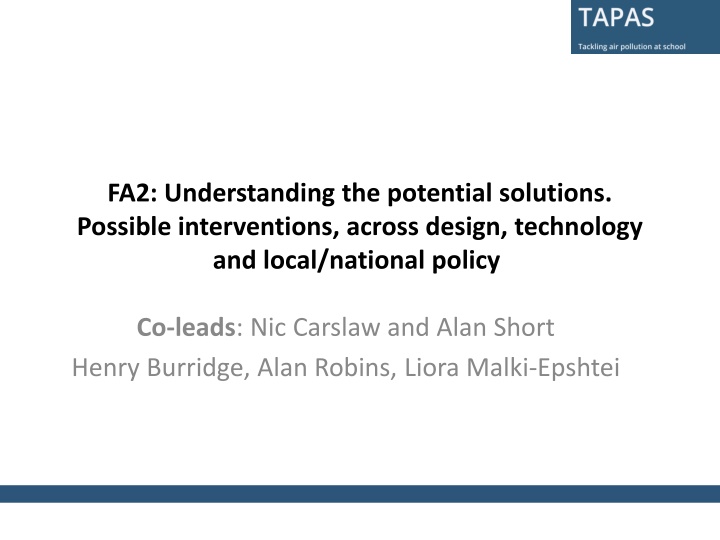
Understanding Potential Solutions for School Air Quality
Explore possible interventions involving building design, technology, and policy to improve air quality in schools. Initiatives include retrofitting, behavioral changes, and public policy interventions. Ongoing activities focus on research, partnerships, and planning for future assessments.
Download Presentation

Please find below an Image/Link to download the presentation.
The content on the website is provided AS IS for your information and personal use only. It may not be sold, licensed, or shared on other websites without obtaining consent from the author. If you encounter any issues during the download, it is possible that the publisher has removed the file from their server.
You are allowed to download the files provided on this website for personal or commercial use, subject to the condition that they are used lawfully. All files are the property of their respective owners.
The content on the website is provided AS IS for your information and personal use only. It may not be sold, licensed, or shared on other websites without obtaining consent from the author.
E N D
Presentation Transcript
FA2: Understanding the potential solutions. Possible interventions, across design, technology and local/national policy Co-leads: Nic Carslaw and Alan Short Henry Burridge, Alan Robins, Liora Malki-Epshtei
Possible solutions Building design and retrofit Ventilation systems, facades, glazing, materials (buildings and furnishings) External interventions e.g. traffic interventions like School Streets, green and blue spaces Behavioural aspects how we use buildings Democratised products to control the environment e.g. intelligent devices, predictive models that can be accessed by schools Managing school locale and travel to and from school Public policy interventions
Balance against cost. 500 m2 office space, 25 occupants, one with influenza.
We will aim to provide a similar review for indoor air quality and then pass on to FA3 to rank effectiveness
Ongoing Activities Split interventions into internal and external Sub-groups will review material to report back at group meetings Review of school buildings to see if we can characterise them Identify partners to help Work towards a review paper and workshop next year Start thinking about links to FA3 need to decide what is the intervention we are aiming at (is it a change of temperature, air changes, pollutant levels etc.) providing a means of comparing the efficacy of different interventions.
Tackling Air Pollution at School (TAPAS) Web: www.tapasnetwork.co.uk Twitter: @TAPASNetwork Email: sb2257@cam.ac.uk
